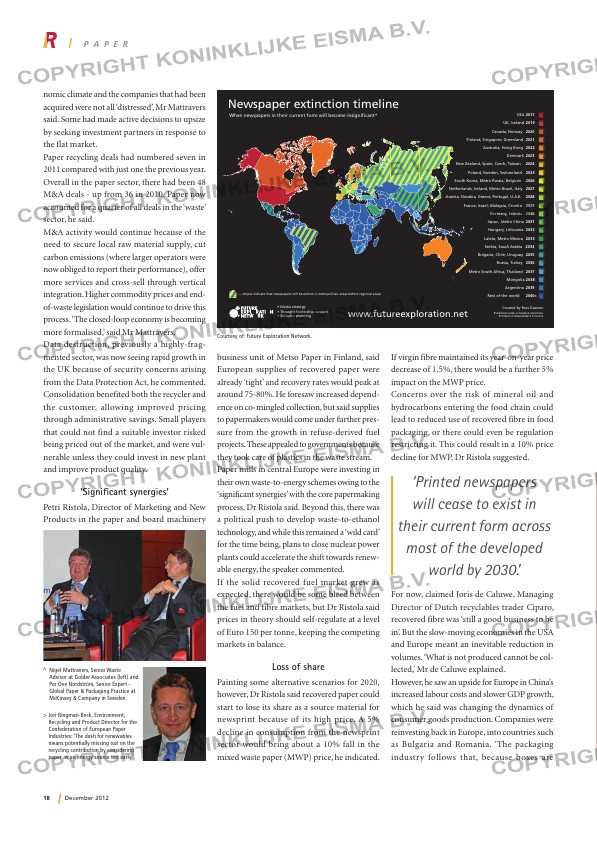Page 18 from: December 2012

18 December 2012
p a p e r
nomic climate and the companies that had been
acquired were not all ‘distressed’, Mr Mattravers
said. Some had made active decisions to upsize
by seeking investment partners in response to
the flat market.
Paper recycling deals had numbered seven in
2011 compared with just one the previous year.
Overall in the paper sector, there had been 48
M&A deals – up from 36 in 2010. Paper now
accounted for a quarter of all deals in the ‘waste’
sector, he said.
M&A activity would continue because of the
need to secure local raw material supply, cut
carbon emissions (where larger operators were
now obliged to report their performance), offer
more services and cross-sell through vertical
integration. Higher commodity prices and end-
of-waste legislation would continue to drive this
process. ‘The closed-loop economy is becoming
more formalised,’ said Mr Mattravers.
Data destruction, previously a highly-frag-
mented sector, was now seeing rapid growth in
the UK because of security concerns arising
from the Data Protection Act, he commented.
Consolidation benefited both the recycler and
the customer, allowing improved pricing
through administrative savings. Small players
that could not find a suitable investor risked
being priced out of the market, and were vul-
nerable unless they could invest in new plant
and improve product quality.
‘Significant synergies’
Petri Ristola, Director of Marketing and New
Products in the paper and board machinery
business unit of Metso Paper in Finland, said
European supplies of recovered paper were
already ‘tight’ and recovery rates would peak at
around 75-80%. He foresaw increased depend-
ence on co-mingled collection, but said supplies
to papermakers would come under further pres-
sure from the growth in refuse-derived fuel
projects. These appealed to governments because
they took care of plastics in the waste stream.
Paper mills in central Europe were investing in
their own waste-to-energy schemes owing to the
‘significant synergies’ with the core papermaking
process, Dr Ristola said. Beyond this, there was
a political push to develop waste-to-ethanol
technology, and while this remained a ‘wild card’
for the time being, plans to close nuclear power
plants could accelerate the shift towards renew-
able energy, the speaker commented.
If the solid recovered fuel market grew as
expected, there would be some bleed between
the fuel and fibre markets, but Dr Ristola said
prices in theory should self-regulate at a level
of Euro 150 per tonne, keeping the competing
markets in balance.
Loss of share
Painting some alternative scenarios for 2020,
however, Dr Ristola said recovered paper could
start to lose its share as a source material for
newsprint because of its high price. A 5%
decline in consumption from the newsprint
sector would bring about a 10% fall in the
mixed waste paper (MWP) price, he indicated.
If virgin fibre maintained its year-on-year price
decrease of 1.5%, there would be a further 5%
impact on the MWP price.
Concerns over the risk of mineral oil and
hydrocarbons entering the food chain could
lead to reduced use of recovered fibre in food
packaging, or there could even be regulation
restricting it. This could result in a 10% price
decline for MWP, Dr Ristola suggested.
For now, claimed Joris de Caluwe, Managing
Director of Dutch recyclables trader Ciparo,
recovered fibre was ‘still a good business to be
in’. But the slow-moving economies in the USA
and Europe meant an inevitable reduction in
volumes. ‘What is not produced cannot be col-
lected,’ Mr de Caluwe explained.
However, he saw an upside for Europe in China’s
increased labour costs and slower GDP growth,
which he said was changing the dynamics of
consumer goods production. Companies were
reinvesting back in Europe, into countries such
as Bulgaria and Romania. ‘The packaging
industry follows that, because boxes are
‘Printed newspapers
will cease to exist in
their current form across
most of the developed
world by 2030.’
Newspaper extinction timeline
• Media strategy
• Thought leadership content
• Scenario planning
Published under a Creative Commons
Attribution-ShareAlike 2.5 licence
Created by Ross Dawson
www.futureexploration.net
— stripes indicate that newspapers will be extinct in metropolitan areas before regional areas
When newspapers in their current form will become insignificant* USA 2017
UK, Iceland 2019
Canada, Norway 2020
Finland, Singapore, Greenland 2021
Australia, Hong Kong 2022
Denmark 2023
New Zealand, Spain, Czech, Taiwan 2024
Poland, Sweden, Switzerland 2025
South Korea, Metro Russia, Belgium 2026
Netherlands, Ireland, Metro Brazil, Italy 2027
Austria, Slovakia, Greece, Portugal, U.A.E. 2028
France, Israel, Malaysia, Croatia 2029
Germany, Estonia 2030
Japan, Metro China 2031
Hungary, Lithuania 2032
Latvia, Metro Mexico 2033
Serbia, Saudi Arabia 2034
Bulgaria, Chile, Uruguay 2035
Russia, Turkey 2036
Metro South Africa, Thailand 2037
Mongolia 2038
Argentina 2039
Rest of the world 2040+
Courtesy of: Future Exploration Network.
Nigel Mattravers, Senior Waste
Advisor at Golder Associates (left) and
Per Ove Nordström, Senior Expert –
Global Paper & Packaging Practice at
McKinsey & Company in Sweden.
> Jori Ringman-Beck, Environment,
Recycling and Product Director for the
Confederation of European Paper
Industries: ‘The dash for renewables
means potentially missing out on the
recycling contribution by considering
paper as an energy source too early.’
<
RI_10-Paper_intro.indd 18 30-11-12 12:09



